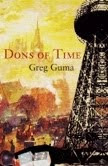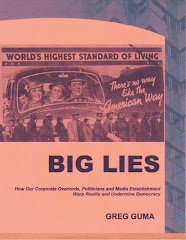Twenty
years ago, in a letter to The Washington Post, Gun Owners of America Director
Larry Pratt made the argument that the only thing separating Americans from the
oppressed peoples of China and the Baltic States was their access to weapons. “When the police have all the guns,” he wrote,
“brutal attacks against defenseless citizens will become as common here as in
other oppressed regimes. This is why gun owners oppose the banning of so-called
assault rifles.”
Does this sound
familiar? It should. The same argument is being made today by that organization
and other pro-gun groups. The only way to prevent a police state, which many people claim is in the works -- in secret, is to allow the wide and unregulated
distribution of all sorts of weapons.
This logic, which assumes that any regulation
is the first step toward confiscation, represents the paranoid and individualist
mentality that for decades has dominated debate about gun violence in the US.
We are free, the argument goes, only as long as we can defend ourselves with
guns not only against criminals but also against the law and the State.
A
related argument is that the federal government should not be allowed to
regulate guns; this is a matter best left to states. And if a state wants to do
nothing, perhaps because the gun lobby can defeat candidates who back even modern reforms, or because the crime rate isn’t soaring or no mass shootings have recently
occurred, people in neighboring states must simply spend more money to
crack down on crime and violence. It’s simply the price of freedom.
Such
arguments are based on the notion that government should not meddle in the
affairs of individuals. Guns are not the problem, opponents add, it’s
people – in other words, human nature. But most homicides in the US are committed
with guns; in other words, people with guns kill more people than those without
them. There are 270 million privately owned firearms in this country. Use by
children has increased in recent years, as has the stockpiling of exotic weapons by
extreme groups and criminal organizations.
Considering
this context, it seems reasonable to ask what is more threatening to freedom
and security, unrestrained gun ownership or some government oversight? The arguments
against regulation tend to fall into three categories: 1) the right to bear
arms is constitutionally protected, 2) gun control won’t reduce violence in
society, and 3) gun laws are a serious threat to freedom.
Do these
assertions hold up to scrutiny?
Arms
and the Law
The
roots of US ideas about the relationship between weapons and society go back to
the Florentine political philosopher Niccolo Machiavelli, who noted that
military service should be the responsibility of every citizen, but soldiering
the professional of none. Basing his ideas on the Roman suspicion of
professional soldiers, he concluded that military force should only be used to
assure the common good. This idea of citizens bearing arms in defense of the
State, to avoid the potential tyranny of a standing army, was translated by the
authors of the Bill of Rights into the Second Amendments and helps to explain
its unusual wording:
“A
well-regulated militia, being necessary to the security of a free State, the
right of the people to keep and bear arms, shall not be infringed.”
Many
libertarians have interpreted this sentence to mean that individuals are guaranteed the
right to possess firearms for their personal defense or for any other use they
choose. What this fails to acknowledge is the meaning of citizenship as it was
understood two centuries ago. In the 18th century, citizenship directly
involved militia service for men, which was part of the commitment to the
greater public good. An armed citizenry did not mean an armed population. In
fact, even then it was clearly understood that access to weapons was a communal
rather than an individual right.
This
dynamic was made clear in various declarations of rights predating the Bill of
Rights. For example, Virginia’s Declaration of Rights, adopted on June 12, 1776,
said that a well-regulated militia, trained to arm, was the safe defense of a
free State. That and subsequent variations adopted by other states made it
clear that the idea was trained citizens, organized in militias, providing for
a common defense. The word “people” refers to this collective role, contrasting
a militia to a standing army.
Article 17 of Vermont’s Declaration of Rights,
adopted in 1777, followed this logic by proclaiming:
“That
the people have a right to bear arms for the defense of themselves and the
State; and as standing armies in time of peace are dangerous to liberty, they
ought not to be kept up; and that the military ought to be kept under strict
subordination to and governed by the civil power.”
Vermont’s
Article 9, which dealt with the matter of conscientious objection to military
service, made it clear that “bearing arms” meant military service. It said that
no one could be compelled to carry or use a gun, even though rights also
involved personal service. The solution was that those who chose not to serve
would pay an appropriate sum on money. Bearing arms was directly linked to the collective
responsibility for defense.
Several
states specifically said that criminals or people involved in rebellion could
be disarmed. In other words, the security of society took precedence over an individual’s right to have weapons. Thus, when early Americans spoke or an
armed citizenry’s role in preserving freedom, they were talking about a militia
linked to the classical idea of citizenship. There is no record of anyone
arguing, during the passage of the Bill of Rights, that individuals had a right
to bear arms outside the ranks of a militia. On the contrary, that provoked fear
for the stability of the new Republic.
The
great constitutional commentator of the period, Justice Joseph Story, noted
that what the Second Amendment actually guaranteed was a “well-regulated
militia.” The fear was that without one the country might be vulnerable to
invasion, domestic insurrection, or a military takeover by some ruler. We
needed a militia, Story said, because it was impractical to keep people armed
without some organization.
The
fear of a militarized society or a federal government monopoly on force is not,
by definition, a form of paranoia. On the other hand, it is an overreach to
claim that individuals have a fundamental right to protect themselves by
stockpiling weapons. For those who want a counter-force to our national military, the
direction to look is greater autonomy of organized local or state militias, not
the right of people to become self-appointed guardians or vigilantes.
Legal
Precedents
Despite
the endless repetition of claims that individuals have a constitutional right
to be armed, this is not consistent with the weight of legal opinion. In fact, a
series of US Supreme Court cases have made the situation quite clear. In U.S.
v. Cruikshank (1876), the Court ruled that the right “of bearing arms for a
lawful purpose is not a right granted by the Constitution.” Ten years later, in
Presser v. Illinois, the Court noted that although states have the right to
form militias, they are also free to regulate the circumstances under which
citizens can carry weapons. This view was upheld in an 1894 case, Miller v.
Texas.
In 1939,
federal gun regulations established by the National Firearms Act of 1934 were challenged. The decision in that case was unanimous. The
federal government has the right, the Court ruled, to regulate the
transportation and possession of firearms, and individuals only have a right to
be armed in connection with military service. In 1980, Justice Harry Blackmun
commented that this case represented the Courts’ basic thinking on gun control.
On
June 8, 1981, the Village of Morton Grove, Illinois passed an ordinance banning
the possession of handguns, except by police, prison officials, members of the
military, recognized collectors and those who needed them for their work.
Predictably, the National Rifle Association challenged the law. Both the
Federal District Court and a Federal Appeals Court rejected their argument, saying that
there is no individual right to bear arms, the ordinance was reasonable, and
the right to have weapons applies only to well-regulated militias.
The
US Supreme Court refused to even hear the case.
Guns
and Crime
Sentiment
in favor on some form of gun control fluctuates, but has tended to grow for
decades. In 1968 71 percent were in favor, peaking at more than 90 percent in
1981. In one Gallop Poll the Brady Bill won 95 percent support. Most people obviously
see some connection between the availability of firearms and the rate of crimes
involving guns, and a variety of studies support these views. Nevertheless,
opponents insist that stronger laws won’t have an impact.
Interstate
trafficking of weapons is an enormous problem, undercutting the argument
sometimes heard that the only reason for gun control is a high murder rate in a
specific state. This provincial argument ignores interdependence, our responsibility
to our neighbors, and basic facts. The only effective way to control the black
market for guns, through gun shows and private sales, is a national registry of
all purchasers, along with tracing and prosecution of the interstate
traffickers. This does not involve rounding up handguns, but it does mean
acknowledging that the situation is out of control and that saving lives takes priority over protecting a form of free enterprise that has turned monstrous.
Leaving
the matter in the hands of individual communities or states may sound
appropriately populous. But it avoids the issue. In 2011 guns were involved in
more than 32,000 US deaths, 11,100 of them murders, as well as thousands of
rapes, hundreds of thousands of robberies, and about a half million assaults.
The vast majority of people convicted of violent crimes obtained their weapons
either at a gun shows or on the black market. That suggests, of course, that background checks alone will not make a
huge dent in the problem. But a reduction of twenty percent would significant; perhaps
one less child killed every day and fewer rapes and murders.
Many crimes involving guns are impulsive,
suggesting that a waiting period could help in some cases. Of course, the underlying causes of violence
and crime must also be addressed. But for those among the 20 percent who might
be saved by modest reforms that would be more meaningful than any
statistic or slogan.
The NRA is fond of saying that “guns don’t
kill people, people kill people.” It’s a tidy little argument but let’s get
real: people with guns can kill people far more effortlessly than people with
knives, deadly fighting skills or poison. The FBI has assembled evidence on whether
stricter laws make a difference. For example, after Massachusetts passed a law requiring a
mandatory jail sentence for carrying a handgun without a license murders
involving handguns dropped by almost 50 percent. Robberies went down 35 percent.
After South Carolina tightened its
handgun purchase requirement in the 1990s, the murder rate dropped 28 percent.
Registration
and background checks are no panacea. However, they do keep weapons out of the
hands of some criminals, addicts and kids. They can also reduce the number of
murder and suicides that result from being able to buy a gun in state of rage
or depression. Drivers licenses and automobile registration do not prevent all
auto accidents – but they help. To drive a car, a potentially dangerous
vehicle, we agree that people need to be properly trained and meet minimum standards. Similar requirements,
in the form of gun safety programs and practical tests for the owners of lethal
weapons, would be a step toward national sanity.
Weapons
and freedom
No
freedom is absolute. Even in the most decentralized and self-managed society,
people must accept some social responsibilities and limits in exchange for
liberty.
Ideally, in a free society citizens participate directly in making
the rules governing their social contract.But even
Michael Bakunin, an anarchist philosopher who took the practice of liberty to a
place some might consider extreme, did not ignore than importance of social
responsibility. Human beings can only fulfill their free individuality by
complementing it through all the individuals around them, he argued. Bakunin
was contemptuous of the type of individualism that asserts the well-being on
one person or group to the detriment of others.
“Total
isolation is intellectual, moral and material death.” he wrote.
When
a disturbed teenager or disgruntled adult commits mass murder it has nothing to
do with liberty. People obviously do not have the right to abuse or destroy the
lives and liberties of others. Yet, when
the issue is guns, many Americans essentially argue that the freedom to be armed is more
important that the right to be safe. Actually, many say that being armed is
the only way to be safe, and therefore any restriction on the access to weapons is a
profound threat to freedom.
Allowing
the government to take any step, argue the opponents of gun regulation, is the
beginning of tyranny. From this vantage point government is the enemy. It would be naive to argument that the government
always uses its power wisely. The political system
cries out for change, if not transformation, if we are ever to have a society
that promotes real equality, justice, respect for diversity, and self-management.
Yet achieving this, empowering people and making step-by-step progress, requires
an appeal to hope rather than fear. Arguing that the only way to be free is to oppose and resist government, in other words knee-jerk
rejection, plays into the hands of the most reactionary forces in society.
Suspicion
of centralized power was clearly a concern of those who created the country. It is still justified and relevant. But the form that most
threatens freedom in the 21st century is the power of powerful, unaccountable
institutions, most of them private, that can influence elections and shaped government
policies. Many of these same interests aggressively argue that freedom means “freedom
from government.” Such appeals are a convenient way to
prevent intrusions into the private “right” to profit and pollute at the expense of the
general health and well-being – to exploit in the name of freedom.
In
the 1970s a Trilateral Commission study candidly concluded that a central
objective of corporate planning in the coming era would be to lower
expectations. People needed to be convinced to expect less, to accept a reduced standard of living and stop demanding that
government solve all their problems. Reagan was not a Trilateralist, but he was
an effective spokesman for the same position. The Clinton administration,
although committed rhetorically to “activist” government, embraced a similar
social and economic agenda.
The bottom line is this: Effective regulation, combined with a
comprehensive national database and a training program for gun users, would
establish over time that less access to guns leads to less violent crime. This has been
the case in Europe and some US states. Success would help shatter the
myth that government is the problem, and that people are better off armed to the
teeth and on their own.
The
debate over guns is not about restricting rights. That’s the cover story, an assumption promoted by the gun lobby to shape public perceptions. It’s not even
about “control,” any more than the fight for affordable housing is secretly a fight for rent control. The goal is security, freedom from the fear and
anxiety sweeping across this over-armed society.
A
well-regulated militia is a altruistic idea, certainly preferable to the
military-industrial complex. But almost 300 million guns in private hands is –
pardon the expression – overkill.
In Switzerland, most adult between 20 and 30
males become members of a militia. They receive training, rifles and ammunition
from the government that are kept in homes. However, handguns are tightly controlled and anyone who wants one must
have a background check and obtain a permit.
In 2010 there were 40 Swiss homicides
involving firearms, for a rate of 0.70 per 100,000. The US rate was 3.6, or five times as high.






























